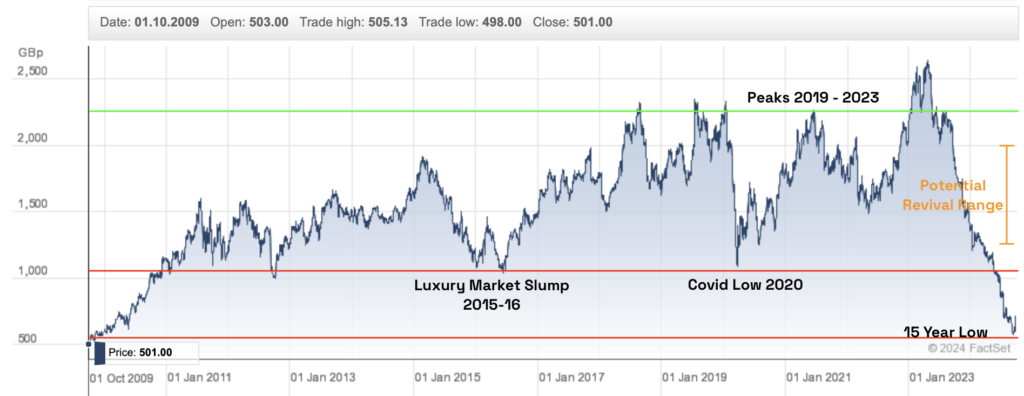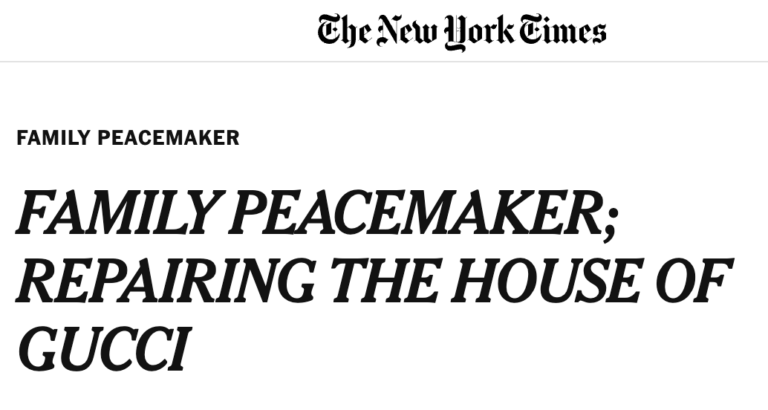I firmly believe that some of the best investment opportunities arise when companies or markets experience turbulence. These moments, when things seem to be off course, can present unique chances to either buy when prices are low or sell when valuations reach unsustainable peaks. In the case of Burberry, the renowned luxury brand, we’re witnessing a situation that may be worth a closer look.
Despite its prestigious history and strong brand recognition, Burberry has faced significant challenges in recent years, leading to a notable decline in its stock price. However, when a company of Burberry’s stature stumbles, it often opens the door for potential long-term opportunities. A brand with over a century of history and a dedicated global following does not fade easily.
The current downturn could provide an attractive entry point for investors with a longer-term outlook, especially those who believe in the company’s ability to adapt and recover.
Burberry’s current state represents a pivotal moment in its journey and presents an opportunity worth reviewing for investors who recognize the potential for turning points.
Review of the Stock Price:
Burberry’s stock has recently hit a 15-year low, trading around 700 GBP, a level not seen since 2009. Over the last 15 years, the stock has experienced significant ups and downs, including a peak above 2,000 GBP between 2019 and 2023 and sharp declines during the luxury market slump in 2015-16 and COVID-19 in 2020.
Burberry has rebounded from downturns in the past, most notably after the 2015-16 slump. With the stock at such a low point, there’s potential for a recovery, with an estimated revival range between 1,500 and 2,000 GBP.
This revival range could represent a possible return on investment of 2-3x from the current stock price, offering a significant upside for investors if Burberry successfully rebounds.
The Odds of a Recovery?
Investing in any company, including Burberry, requires weighing multiple factors, including financial health, market trends, company strategy, and external risks. Based on the historical analysis of luxury brands that have recovered after downturns and Burberry’s unique strengths, let’s break down the odds of recovery from an investor’s perspective.
Key Considerations for Investing in Burberry:
- Burberry’s Strengths and Heritage:
- Strong Brand Equity: Burberry remains one of the most recognizable names in luxury fashion, with a century of heritage. This alone gives it an advantage in the luxury sector, as brand loyalty and history are significant drivers of consumer behavior.
- Previous Successful Turnaround: Burberry has been in a difficult position before and has successfully repositioned itself. This shows that it has the capacity to navigate difficult periods and emerge stronger.
- Core Products and Iconic Designs: The brand’s association with its trench coat and British luxury identity can serve as a core element for recovery. A return to heritage-focused product lines could appeal to both loyal customers and a new generation of luxury consumers.
- Market Conditions in the Luxury Sector:
- Resilience of the Luxury Market: Historically, the luxury sector tends to be more resilient than other industries during economic downturns, as affluent consumers are less affected by economic volatility. This trend could benefit Burberry, especially in key markets like China and North America.
- Potential for Growth in Asia: Burberry has strong brand recognition in Asia, particularly in China, which is a crucial growth region for luxury brands. As these markets recover post-pandemic, Burberry’s position in Asia could lead to strong gains.
- Challenges and Risks:
- Intense Competition: Burberry operates in an ultra-competitive environment alongside well-established brands like Louis Vuitton, Gucci, and Chanel, which have shown strong performance. Burberry must differentiate itself creatively and operationally to win back market share.
- Execution Risk: A recovery depends on strong leadership and clear strategic direction. The luxury market can be unforgiving if the brand doesn’t align with consumer trends, such as sustainability and digital engagement.
- Global Economic Uncertainty: Inflation, interest rate hikes, and the potential for economic downturns could impact consumer spending on luxury goods. Burberry’s performance will be affected by how resilient its target market is to these macroeconomic factors.
- Recent Strategic Shifts:
- New Leadership: Burberry recently appointed Daniel Lee as Chief Creative Officer, signaling a possible new creative direction. His previous success at Bottega Veneta in modernizing the brand while respecting heritage could bode well for Burberry’s future under his leadership.
Digital and Sustainability Focus: Burberry has invested heavily in digital platforms and sustainability, aligning with current luxury market trends. If executed well, these investments could help capture a growing market of younger, more environmentally conscious consumers.
Odds of a Recovery:
Based on historical cases of other luxury brands, Burberry has a reasonable chance of recovery. Brands like Gucci and Chanel were able to stage remarkable comebacks after periods of stagnation due to the following:
- Creative rejuvenation: New leadership and design changes that re-energized the brand.
- Strategic realignment: A renewed focus on core products, exclusivity, and a more disciplined approach to operations.
If Burberry can successfully execute a similar turnaround strategy by focusing on its iconic products, increasing its digital presence, and appealing to younger luxury consumers, the odds of recovery are strong. However, the timeframe for a full recovery could be longer depending on external factors like economic conditions and the execution of new strategies.
Investment Decision - Pros & Cons:
Pros:
- Brand Recognition: Burberry has strong brand recognition and a history of weathering downturns.
- Upside Potential: If the brand successfully implements a turnaround strategy, the stock could offer significant upside as market sentiment improves.
- Market Growth in Asia: The potential for growth in China and other key markets is substantial, especially as the luxury market in these regions recovers.
Cons:
- Execution Risk: Turnarounds in the luxury sector can be challenging and require strong creative leadership and a clear strategic plan. Missteps in product design, branding, or execution could delay or limit recovery.
- Competitive Landscape: Burberry faces stiff competition from other luxury players that have been outperforming, and it will need to differentiate itself in a crowded market.
Economic Risks: Economic uncertainty (such as inflation and geopolitical tensions) could reduce consumer spending on discretionary items like luxury goods, impacting recovery efforts.
Conclusion - Should You Invest?
If you believe in Burberry’s ability to execute a successful turnaround—based on new leadership, brand heritage, and potential in growth markets like China—it may be worth considering as a medium- to long-term investment. However, given the competitive landscape and execution risks, it is important to approach the investment with caution. You might consider:
- Monitoring Short-Term Performance: Watch for early signs of strategic success under new leadership, including positive consumer reception to new collections and growth in key markets.
- Risk Management: Consider investing a small portion of your portfolio if you are willing to take on the risk associated with a turnaround play.
In summary, while Burberry’s recovery isn’t guaranteed, historical precedents of other luxury brands suggest it has a standing chance. The potential for recovery is there, but patience and close monitoring of execution will be key.
Disclaimer: This MyArkade blog is intended to provide general information. Our commentary is based solely on historical data and analyst research, using an impartial methodology. The content is not meant to serve as financial advice and should not be considered a recommendation to buy or sell any stock. It does not take into account your personal objectives or financial situation. Our goal is to offer long-term, data-driven analysis grounded in fundamental information. Please note that our analysis may not reflect recent company announcements or qualitative factors. MyArkade holds no positions in any of the stocks discussed.














